Best Practices Manual: Corporate Culture and Management Systems
VerifiedAdded on 2022/05/13
|12
|3736
|15
Report
AI Summary
This report provides a comprehensive overview of best practices for various aspects of business development and organizational management. It covers essential elements such as building a sustainable corporate culture, including employee motivation, ethical practices, and collaborative approaches. The report also delves into audit management systems, emphasizing the importance of evaluating auditors, implementing effective processes, and mitigating risks. Additionally, it addresses conflict resolution strategies for workgroups, personal conflicts, and corporate politics. Furthermore, the report explores best practices for organizational design and structure, highlighting the need for adaptability, technological advancements, and strategic endeavors. The content emphasizes the significance of understanding client and investor differences, designing effective organizational frameworks, and fostering employee development. Overall, the report provides valuable insights and practical strategies for enhancing organizational performance and promoting a positive work environment.
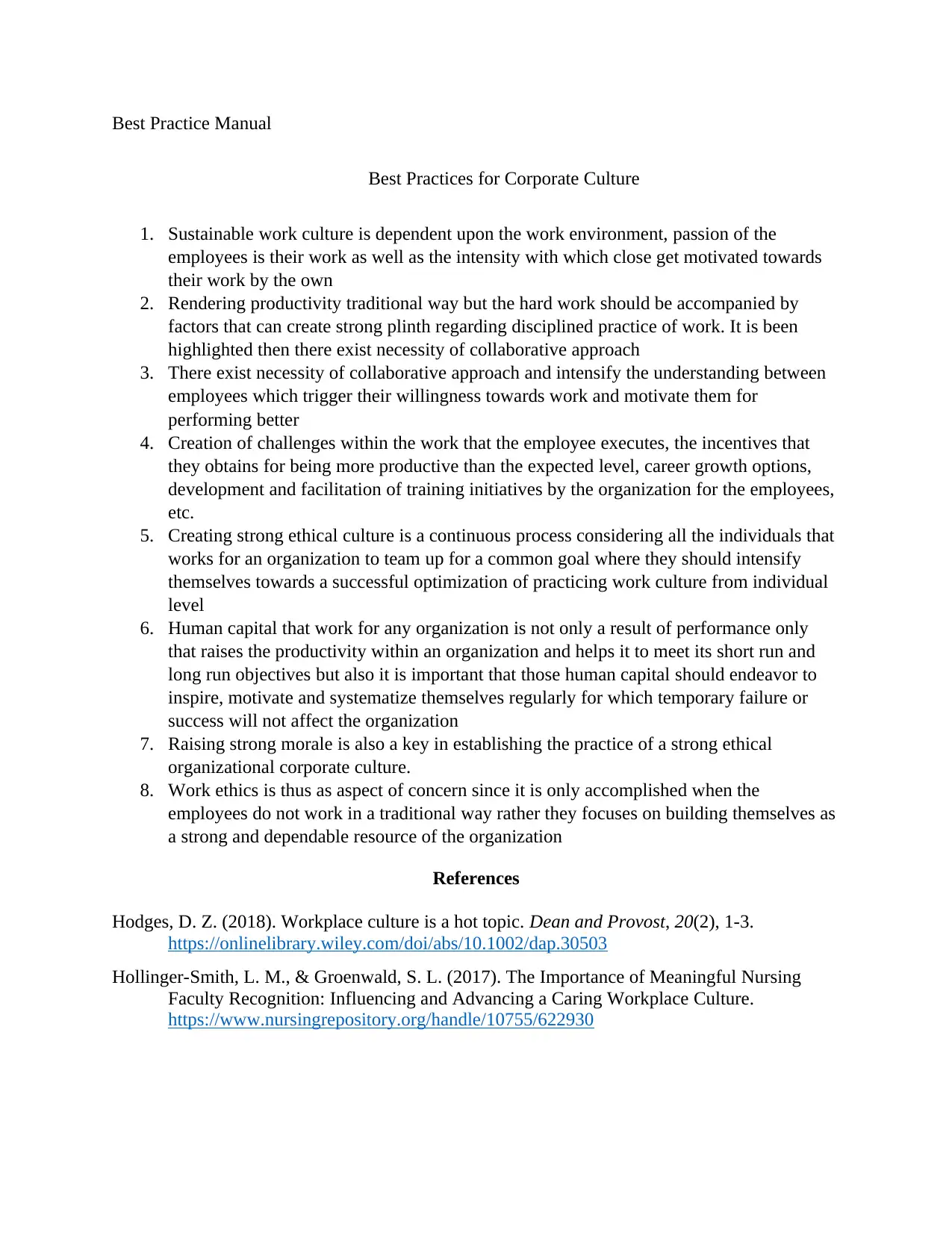
Best Practice Manual
Best Practices for Corporate Culture
1. Sustainable work culture is dependent upon the work environment, passion of the
employees is their work as well as the intensity with which close get motivated towards
their work by the own
2. Rendering productivity traditional way but the hard work should be accompanied by
factors that can create strong plinth regarding disciplined practice of work. It is been
highlighted then there exist necessity of collaborative approach
3. There exist necessity of collaborative approach and intensify the understanding between
employees which trigger their willingness towards work and motivate them for
performing better
4. Creation of challenges within the work that the employee executes, the incentives that
they obtains for being more productive than the expected level, career growth options,
development and facilitation of training initiatives by the organization for the employees,
etc.
5. Creating strong ethical culture is a continuous process considering all the individuals that
works for an organization to team up for a common goal where they should intensify
themselves towards a successful optimization of practicing work culture from individual
level
6. Human capital that work for any organization is not only a result of performance only
that raises the productivity within an organization and helps it to meet its short run and
long run objectives but also it is important that those human capital should endeavor to
inspire, motivate and systematize themselves regularly for which temporary failure or
success will not affect the organization
7. Raising strong morale is also a key in establishing the practice of a strong ethical
organizational corporate culture.
8. Work ethics is thus as aspect of concern since it is only accomplished when the
employees do not work in a traditional way rather they focuses on building themselves as
a strong and dependable resource of the organization
References
Hodges, D. Z. (2018). Workplace culture is a hot topic. Dean and Provost, 20(2), 1-3.
https://onlinelibrary.wiley.com/doi/abs/10.1002/dap.30503
Hollinger-Smith, L. M., & Groenwald, S. L. (2017). The Importance of Meaningful Nursing
Faculty Recognition: Influencing and Advancing a Caring Workplace Culture.
https://www.nursingrepository.org/handle/10755/622930
Best Practices for Corporate Culture
1. Sustainable work culture is dependent upon the work environment, passion of the
employees is their work as well as the intensity with which close get motivated towards
their work by the own
2. Rendering productivity traditional way but the hard work should be accompanied by
factors that can create strong plinth regarding disciplined practice of work. It is been
highlighted then there exist necessity of collaborative approach
3. There exist necessity of collaborative approach and intensify the understanding between
employees which trigger their willingness towards work and motivate them for
performing better
4. Creation of challenges within the work that the employee executes, the incentives that
they obtains for being more productive than the expected level, career growth options,
development and facilitation of training initiatives by the organization for the employees,
etc.
5. Creating strong ethical culture is a continuous process considering all the individuals that
works for an organization to team up for a common goal where they should intensify
themselves towards a successful optimization of practicing work culture from individual
level
6. Human capital that work for any organization is not only a result of performance only
that raises the productivity within an organization and helps it to meet its short run and
long run objectives but also it is important that those human capital should endeavor to
inspire, motivate and systematize themselves regularly for which temporary failure or
success will not affect the organization
7. Raising strong morale is also a key in establishing the practice of a strong ethical
organizational corporate culture.
8. Work ethics is thus as aspect of concern since it is only accomplished when the
employees do not work in a traditional way rather they focuses on building themselves as
a strong and dependable resource of the organization
References
Hodges, D. Z. (2018). Workplace culture is a hot topic. Dean and Provost, 20(2), 1-3.
https://onlinelibrary.wiley.com/doi/abs/10.1002/dap.30503
Hollinger-Smith, L. M., & Groenwald, S. L. (2017). The Importance of Meaningful Nursing
Faculty Recognition: Influencing and Advancing a Caring Workplace Culture.
https://www.nursingrepository.org/handle/10755/622930
Paraphrase This Document
Need a fresh take? Get an instant paraphrase of this document with our AI Paraphraser
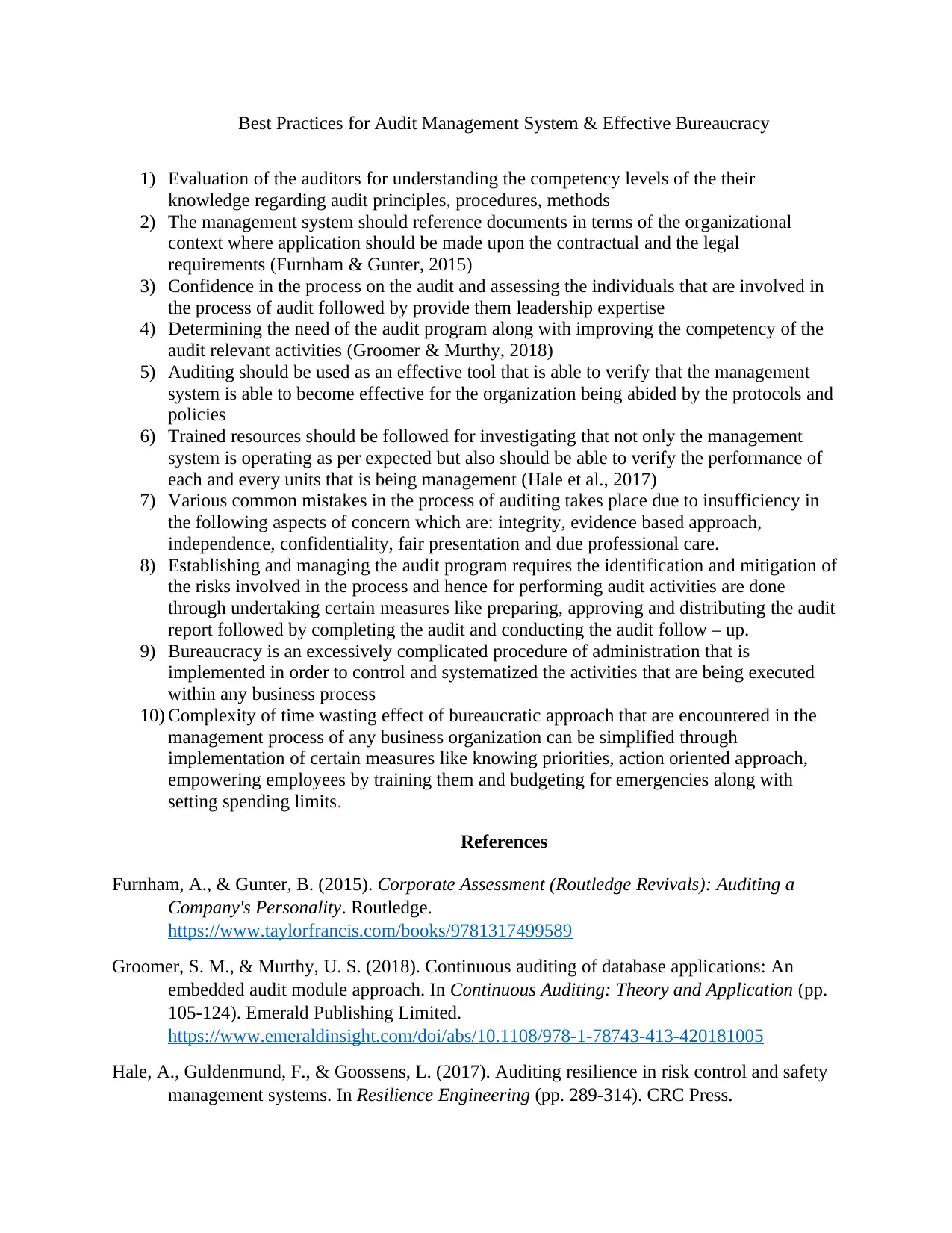
Best Practices for Audit Management System & Effective Bureaucracy
1) Evaluation of the auditors for understanding the competency levels of the their
knowledge regarding audit principles, procedures, methods
2) The management system should reference documents in terms of the organizational
context where application should be made upon the contractual and the legal
requirements (Furnham & Gunter, 2015)
3) Confidence in the process on the audit and assessing the individuals that are involved in
the process of audit followed by provide them leadership expertise
4) Determining the need of the audit program along with improving the competency of the
audit relevant activities (Groomer & Murthy, 2018)
5) Auditing should be used as an effective tool that is able to verify that the management
system is able to become effective for the organization being abided by the protocols and
policies
6) Trained resources should be followed for investigating that not only the management
system is operating as per expected but also should be able to verify the performance of
each and every units that is being management (Hale et al., 2017)
7) Various common mistakes in the process of auditing takes place due to insufficiency in
the following aspects of concern which are: integrity, evidence based approach,
independence, confidentiality, fair presentation and due professional care.
8) Establishing and managing the audit program requires the identification and mitigation of
the risks involved in the process and hence for performing audit activities are done
through undertaking certain measures like preparing, approving and distributing the audit
report followed by completing the audit and conducting the audit follow – up.
9) Bureaucracy is an excessively complicated procedure of administration that is
implemented in order to control and systematized the activities that are being executed
within any business process
10) Complexity of time wasting effect of bureaucratic approach that are encountered in the
management process of any business organization can be simplified through
implementation of certain measures like knowing priorities, action oriented approach,
empowering employees by training them and budgeting for emergencies along with
setting spending limits.
References
Furnham, A., & Gunter, B. (2015). Corporate Assessment (Routledge Revivals): Auditing a
Company's Personality. Routledge.
https://www.taylorfrancis.com/books/9781317499589
Groomer, S. M., & Murthy, U. S. (2018). Continuous auditing of database applications: An
embedded audit module approach. In Continuous Auditing: Theory and Application (pp.
105-124). Emerald Publishing Limited.
https://www.emeraldinsight.com/doi/abs/10.1108/978-1-78743-413-420181005
Hale, A., Guldenmund, F., & Goossens, L. (2017). Auditing resilience in risk control and safety
management systems. In Resilience Engineering (pp. 289-314). CRC Press.
1) Evaluation of the auditors for understanding the competency levels of the their
knowledge regarding audit principles, procedures, methods
2) The management system should reference documents in terms of the organizational
context where application should be made upon the contractual and the legal
requirements (Furnham & Gunter, 2015)
3) Confidence in the process on the audit and assessing the individuals that are involved in
the process of audit followed by provide them leadership expertise
4) Determining the need of the audit program along with improving the competency of the
audit relevant activities (Groomer & Murthy, 2018)
5) Auditing should be used as an effective tool that is able to verify that the management
system is able to become effective for the organization being abided by the protocols and
policies
6) Trained resources should be followed for investigating that not only the management
system is operating as per expected but also should be able to verify the performance of
each and every units that is being management (Hale et al., 2017)
7) Various common mistakes in the process of auditing takes place due to insufficiency in
the following aspects of concern which are: integrity, evidence based approach,
independence, confidentiality, fair presentation and due professional care.
8) Establishing and managing the audit program requires the identification and mitigation of
the risks involved in the process and hence for performing audit activities are done
through undertaking certain measures like preparing, approving and distributing the audit
report followed by completing the audit and conducting the audit follow – up.
9) Bureaucracy is an excessively complicated procedure of administration that is
implemented in order to control and systematized the activities that are being executed
within any business process
10) Complexity of time wasting effect of bureaucratic approach that are encountered in the
management process of any business organization can be simplified through
implementation of certain measures like knowing priorities, action oriented approach,
empowering employees by training them and budgeting for emergencies along with
setting spending limits.
References
Furnham, A., & Gunter, B. (2015). Corporate Assessment (Routledge Revivals): Auditing a
Company's Personality. Routledge.
https://www.taylorfrancis.com/books/9781317499589
Groomer, S. M., & Murthy, U. S. (2018). Continuous auditing of database applications: An
embedded audit module approach. In Continuous Auditing: Theory and Application (pp.
105-124). Emerald Publishing Limited.
https://www.emeraldinsight.com/doi/abs/10.1108/978-1-78743-413-420181005
Hale, A., Guldenmund, F., & Goossens, L. (2017). Auditing resilience in risk control and safety
management systems. In Resilience Engineering (pp. 289-314). CRC Press.

https://www.taylorfrancis.com/books/e/9781317065296/chapters/10.1201/978131560568
5-25
Best practices for controlling conflicts between workgroups, personal conflicts, and corporate
politics
1. Exclude the notion of being right and always winning. The reason why conflicts escalate
is that each person considers his or her argument to be the right one and to be the only
one winning.
2. Look for a root cause instead of looking for people to blame.
3. Try to eliminate emotions while dealing with issues.
4. Work with others when looking for solutions to an issue (De Dreu, 2015).
5. Conversations should be goal-oriented, and this means that issues that do not help in
solving the conflict should be avoided.
6. Establish an engaging conversation while dealing with conflicts and this is because
communication is essential in the whole process.
7. Factor in the feelings of other involved parties (Prause & Mujtaba, 2015).
8. Focus on behavior rather than personality.
9. Create an engaging environment.
10. Know and understand the issues that need to be addressed privately and the issues that
need to be dealt with in public.
5-25
Best practices for controlling conflicts between workgroups, personal conflicts, and corporate
politics
1. Exclude the notion of being right and always winning. The reason why conflicts escalate
is that each person considers his or her argument to be the right one and to be the only
one winning.
2. Look for a root cause instead of looking for people to blame.
3. Try to eliminate emotions while dealing with issues.
4. Work with others when looking for solutions to an issue (De Dreu, 2015).
5. Conversations should be goal-oriented, and this means that issues that do not help in
solving the conflict should be avoided.
6. Establish an engaging conversation while dealing with conflicts and this is because
communication is essential in the whole process.
7. Factor in the feelings of other involved parties (Prause & Mujtaba, 2015).
8. Focus on behavior rather than personality.
9. Create an engaging environment.
10. Know and understand the issues that need to be addressed privately and the issues that
need to be dealt with in public.
⊘ This is a preview!⊘
Do you want full access?
Subscribe today to unlock all pages.

Trusted by 1+ million students worldwide
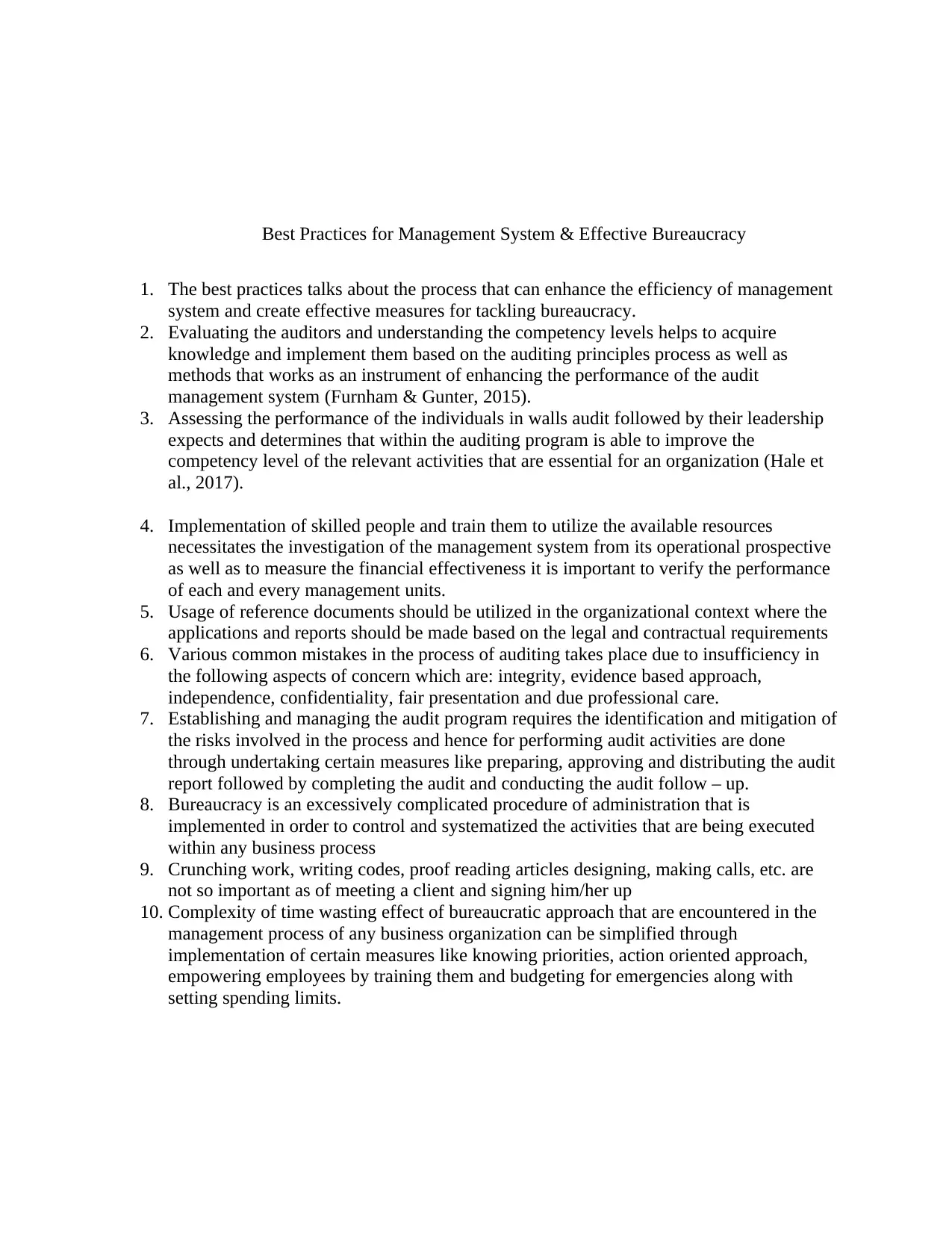
Best Practices for Management System & Effective Bureaucracy
1. The best practices talks about the process that can enhance the efficiency of management
system and create effective measures for tackling bureaucracy.
2. Evaluating the auditors and understanding the competency levels helps to acquire
knowledge and implement them based on the auditing principles process as well as
methods that works as an instrument of enhancing the performance of the audit
management system (Furnham & Gunter, 2015).
3. Assessing the performance of the individuals in walls audit followed by their leadership
expects and determines that within the auditing program is able to improve the
competency level of the relevant activities that are essential for an organization (Hale et
al., 2017).
4. Implementation of skilled people and train them to utilize the available resources
necessitates the investigation of the management system from its operational prospective
as well as to measure the financial effectiveness it is important to verify the performance
of each and every management units.
5. Usage of reference documents should be utilized in the organizational context where the
applications and reports should be made based on the legal and contractual requirements
6. Various common mistakes in the process of auditing takes place due to insufficiency in
the following aspects of concern which are: integrity, evidence based approach,
independence, confidentiality, fair presentation and due professional care.
7. Establishing and managing the audit program requires the identification and mitigation of
the risks involved in the process and hence for performing audit activities are done
through undertaking certain measures like preparing, approving and distributing the audit
report followed by completing the audit and conducting the audit follow – up.
8. Bureaucracy is an excessively complicated procedure of administration that is
implemented in order to control and systematized the activities that are being executed
within any business process
9. Crunching work, writing codes, proof reading articles designing, making calls, etc. are
not so important as of meeting a client and signing him/her up
10. Complexity of time wasting effect of bureaucratic approach that are encountered in the
management process of any business organization can be simplified through
implementation of certain measures like knowing priorities, action oriented approach,
empowering employees by training them and budgeting for emergencies along with
setting spending limits.
1. The best practices talks about the process that can enhance the efficiency of management
system and create effective measures for tackling bureaucracy.
2. Evaluating the auditors and understanding the competency levels helps to acquire
knowledge and implement them based on the auditing principles process as well as
methods that works as an instrument of enhancing the performance of the audit
management system (Furnham & Gunter, 2015).
3. Assessing the performance of the individuals in walls audit followed by their leadership
expects and determines that within the auditing program is able to improve the
competency level of the relevant activities that are essential for an organization (Hale et
al., 2017).
4. Implementation of skilled people and train them to utilize the available resources
necessitates the investigation of the management system from its operational prospective
as well as to measure the financial effectiveness it is important to verify the performance
of each and every management units.
5. Usage of reference documents should be utilized in the organizational context where the
applications and reports should be made based on the legal and contractual requirements
6. Various common mistakes in the process of auditing takes place due to insufficiency in
the following aspects of concern which are: integrity, evidence based approach,
independence, confidentiality, fair presentation and due professional care.
7. Establishing and managing the audit program requires the identification and mitigation of
the risks involved in the process and hence for performing audit activities are done
through undertaking certain measures like preparing, approving and distributing the audit
report followed by completing the audit and conducting the audit follow – up.
8. Bureaucracy is an excessively complicated procedure of administration that is
implemented in order to control and systematized the activities that are being executed
within any business process
9. Crunching work, writing codes, proof reading articles designing, making calls, etc. are
not so important as of meeting a client and signing him/her up
10. Complexity of time wasting effect of bureaucratic approach that are encountered in the
management process of any business organization can be simplified through
implementation of certain measures like knowing priorities, action oriented approach,
empowering employees by training them and budgeting for emergencies along with
setting spending limits.
Paraphrase This Document
Need a fresh take? Get an instant paraphrase of this document with our AI Paraphraser
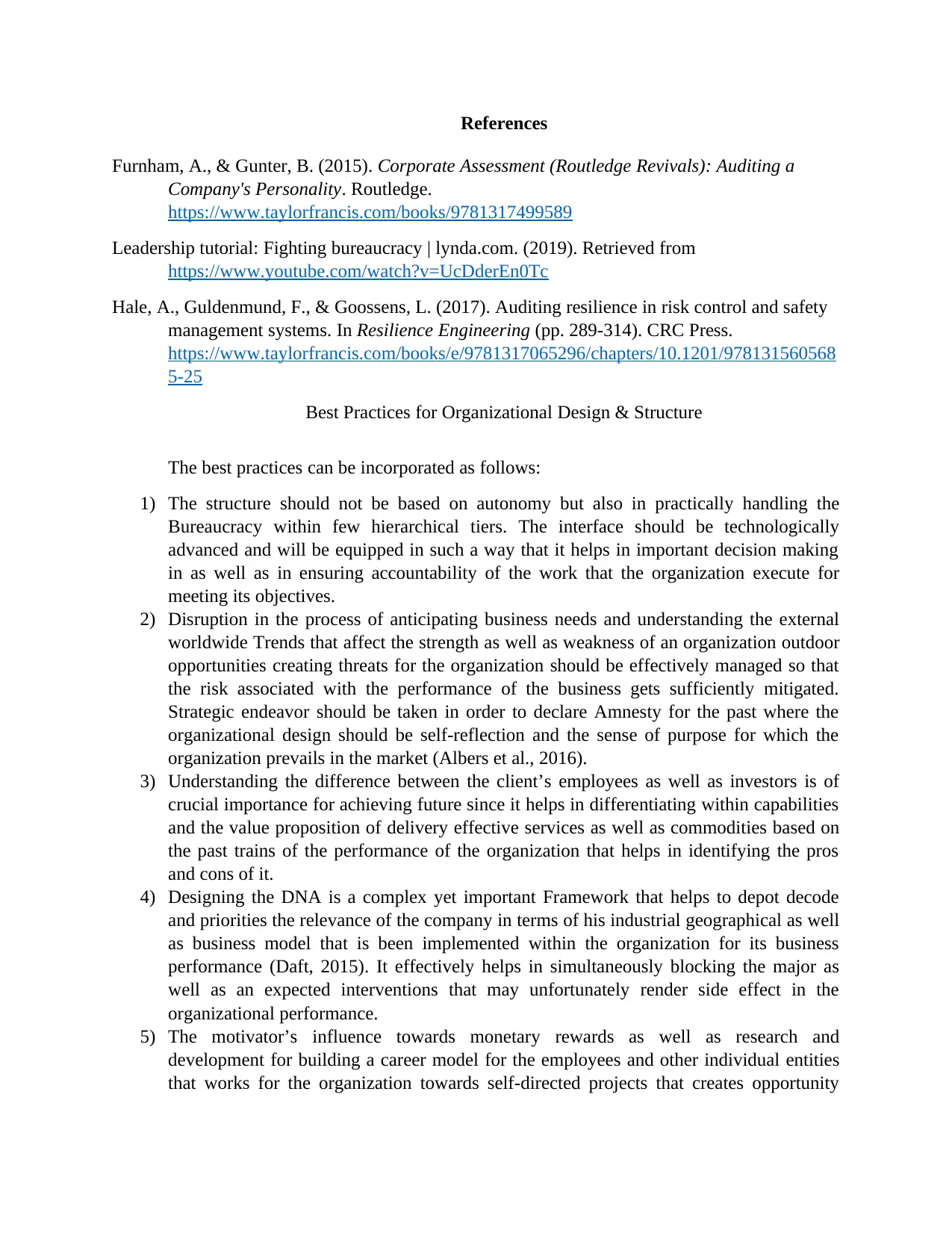
References
Furnham, A., & Gunter, B. (2015). Corporate Assessment (Routledge Revivals): Auditing a
Company's Personality. Routledge.
https://www.taylorfrancis.com/books/9781317499589
Leadership tutorial: Fighting bureaucracy | lynda.com. (2019). Retrieved from
https://www.youtube.com/watch?v=UcDderEn0Tc
Hale, A., Guldenmund, F., & Goossens, L. (2017). Auditing resilience in risk control and safety
management systems. In Resilience Engineering (pp. 289-314). CRC Press.
https://www.taylorfrancis.com/books/e/9781317065296/chapters/10.1201/978131560568
5-25
Best Practices for Organizational Design & Structure
The best practices can be incorporated as follows:
1) The structure should not be based on autonomy but also in practically handling the
Bureaucracy within few hierarchical tiers. The interface should be technologically
advanced and will be equipped in such a way that it helps in important decision making
in as well as in ensuring accountability of the work that the organization execute for
meeting its objectives.
2) Disruption in the process of anticipating business needs and understanding the external
worldwide Trends that affect the strength as well as weakness of an organization outdoor
opportunities creating threats for the organization should be effectively managed so that
the risk associated with the performance of the business gets sufficiently mitigated.
Strategic endeavor should be taken in order to declare Amnesty for the past where the
organizational design should be self-reflection and the sense of purpose for which the
organization prevails in the market (Albers et al., 2016).
3) Understanding the difference between the client’s employees as well as investors is of
crucial importance for achieving future since it helps in differentiating within capabilities
and the value proposition of delivery effective services as well as commodities based on
the past trains of the performance of the organization that helps in identifying the pros
and cons of it.
4) Designing the DNA is a complex yet important Framework that helps to depot decode
and priorities the relevance of the company in terms of his industrial geographical as well
as business model that is been implemented within the organization for its business
performance (Daft, 2015). It effectively helps in simultaneously blocking the major as
well as an expected interventions that may unfortunately render side effect in the
organizational performance.
5) The motivator’s influence towards monetary rewards as well as research and
development for building a career model for the employees and other individual entities
that works for the organization towards self-directed projects that creates opportunity
Furnham, A., & Gunter, B. (2015). Corporate Assessment (Routledge Revivals): Auditing a
Company's Personality. Routledge.
https://www.taylorfrancis.com/books/9781317499589
Leadership tutorial: Fighting bureaucracy | lynda.com. (2019). Retrieved from
https://www.youtube.com/watch?v=UcDderEn0Tc
Hale, A., Guldenmund, F., & Goossens, L. (2017). Auditing resilience in risk control and safety
management systems. In Resilience Engineering (pp. 289-314). CRC Press.
https://www.taylorfrancis.com/books/e/9781317065296/chapters/10.1201/978131560568
5-25
Best Practices for Organizational Design & Structure
The best practices can be incorporated as follows:
1) The structure should not be based on autonomy but also in practically handling the
Bureaucracy within few hierarchical tiers. The interface should be technologically
advanced and will be equipped in such a way that it helps in important decision making
in as well as in ensuring accountability of the work that the organization execute for
meeting its objectives.
2) Disruption in the process of anticipating business needs and understanding the external
worldwide Trends that affect the strength as well as weakness of an organization outdoor
opportunities creating threats for the organization should be effectively managed so that
the risk associated with the performance of the business gets sufficiently mitigated.
Strategic endeavor should be taken in order to declare Amnesty for the past where the
organizational design should be self-reflection and the sense of purpose for which the
organization prevails in the market (Albers et al., 2016).
3) Understanding the difference between the client’s employees as well as investors is of
crucial importance for achieving future since it helps in differentiating within capabilities
and the value proposition of delivery effective services as well as commodities based on
the past trains of the performance of the organization that helps in identifying the pros
and cons of it.
4) Designing the DNA is a complex yet important Framework that helps to depot decode
and priorities the relevance of the company in terms of his industrial geographical as well
as business model that is been implemented within the organization for its business
performance (Daft, 2015). It effectively helps in simultaneously blocking the major as
well as an expected interventions that may unfortunately render side effect in the
organizational performance.
5) The motivator’s influence towards monetary rewards as well as research and
development for building a career model for the employees and other individual entities
that works for the organization towards self-directed projects that creates opportunity

along with external collaboration and facilitation of training and educational
development.
References
Daft, R. L. (2015). Organization theory and design. Cengage learning.
https://books.google.co.in/books?
hl=en&lr=&id=yPq5BwAAQBAJ&oi=fnd&pg=PR3&dq=organization+Structure+
%26+Design&ots=sYkGrW5ayP&sig=N8MbrIZxmHH9ZRR4nPx1JNvvaJI
Best Practices for Organizational Design & Structure
6) It is important not to create the structure fast but last after understanding the performance
that is being demanded from the organization as well as reporting the relationship within
the company hierarchy the equilibrium towards significant management layers and not
upon temporary reduction of cost. Due to the organizational structure it may happen that
short-term games Mein disappear but redesigning towards a new form for the
organization with sequential intervention by the authority as well as the bottom line
employees may lead to creation of a cornerstone that will ensure its sustenance for the
long run (Miterev et al., 2017).
7) The top talents within the organization may be inclusive of the personalities and the
capabilities of the other resources that exist within the team members as well as the
executive should be effectively utilized in order to realize the strength of the people that
are skilled and are willing to remain with the managerial achievement of the organization
for fostering collaboration empowerment and organizational leads to their leadership
strategization. The focus will be on what can be controlled for exam to the scarcity of
sources or in finding out the short term supply. It may be also regarding the consistent
slow down on the constants that the company is confronting due to real devolved
limitations additional structure in accordance with the regulations, supply shortages as
well as change in the customer demands of fluctuation in the market price. Instead of
focusing upon the change it can also focus upon the Global consumer demand packages
of goods and services and understand the Global framework of decision rights in terms of
branding guidelines for policy formulation due to continuous change in the consumer
taste preference of demand that delegate the decision rights for the business leaders
(Zhang & Liu, 2017).
8) Promoting accountability regarding the organizational walk and micro managing the
information flow in a transparent way to rapidly within the business units functional
departments as well as the final outlets is very important since it reinforce the
effectiveness of an organization by continually nurturing its resources and promoting
them to produce good quality products and services as per the, commitments done
towards the end consumers. Notably this undermines the desired behavior of the
consumers that may demand discounts in the products and services as well as the
development.
References
Daft, R. L. (2015). Organization theory and design. Cengage learning.
https://books.google.co.in/books?
hl=en&lr=&id=yPq5BwAAQBAJ&oi=fnd&pg=PR3&dq=organization+Structure+
%26+Design&ots=sYkGrW5ayP&sig=N8MbrIZxmHH9ZRR4nPx1JNvvaJI
Best Practices for Organizational Design & Structure
6) It is important not to create the structure fast but last after understanding the performance
that is being demanded from the organization as well as reporting the relationship within
the company hierarchy the equilibrium towards significant management layers and not
upon temporary reduction of cost. Due to the organizational structure it may happen that
short-term games Mein disappear but redesigning towards a new form for the
organization with sequential intervention by the authority as well as the bottom line
employees may lead to creation of a cornerstone that will ensure its sustenance for the
long run (Miterev et al., 2017).
7) The top talents within the organization may be inclusive of the personalities and the
capabilities of the other resources that exist within the team members as well as the
executive should be effectively utilized in order to realize the strength of the people that
are skilled and are willing to remain with the managerial achievement of the organization
for fostering collaboration empowerment and organizational leads to their leadership
strategization. The focus will be on what can be controlled for exam to the scarcity of
sources or in finding out the short term supply. It may be also regarding the consistent
slow down on the constants that the company is confronting due to real devolved
limitations additional structure in accordance with the regulations, supply shortages as
well as change in the customer demands of fluctuation in the market price. Instead of
focusing upon the change it can also focus upon the Global consumer demand packages
of goods and services and understand the Global framework of decision rights in terms of
branding guidelines for policy formulation due to continuous change in the consumer
taste preference of demand that delegate the decision rights for the business leaders
(Zhang & Liu, 2017).
8) Promoting accountability regarding the organizational walk and micro managing the
information flow in a transparent way to rapidly within the business units functional
departments as well as the final outlets is very important since it reinforce the
effectiveness of an organization by continually nurturing its resources and promoting
them to produce good quality products and services as per the, commitments done
towards the end consumers. Notably this undermines the desired behavior of the
consumers that may demand discounts in the products and services as well as the
⊘ This is a preview!⊘
Do you want full access?
Subscribe today to unlock all pages.

Trusted by 1+ million students worldwide
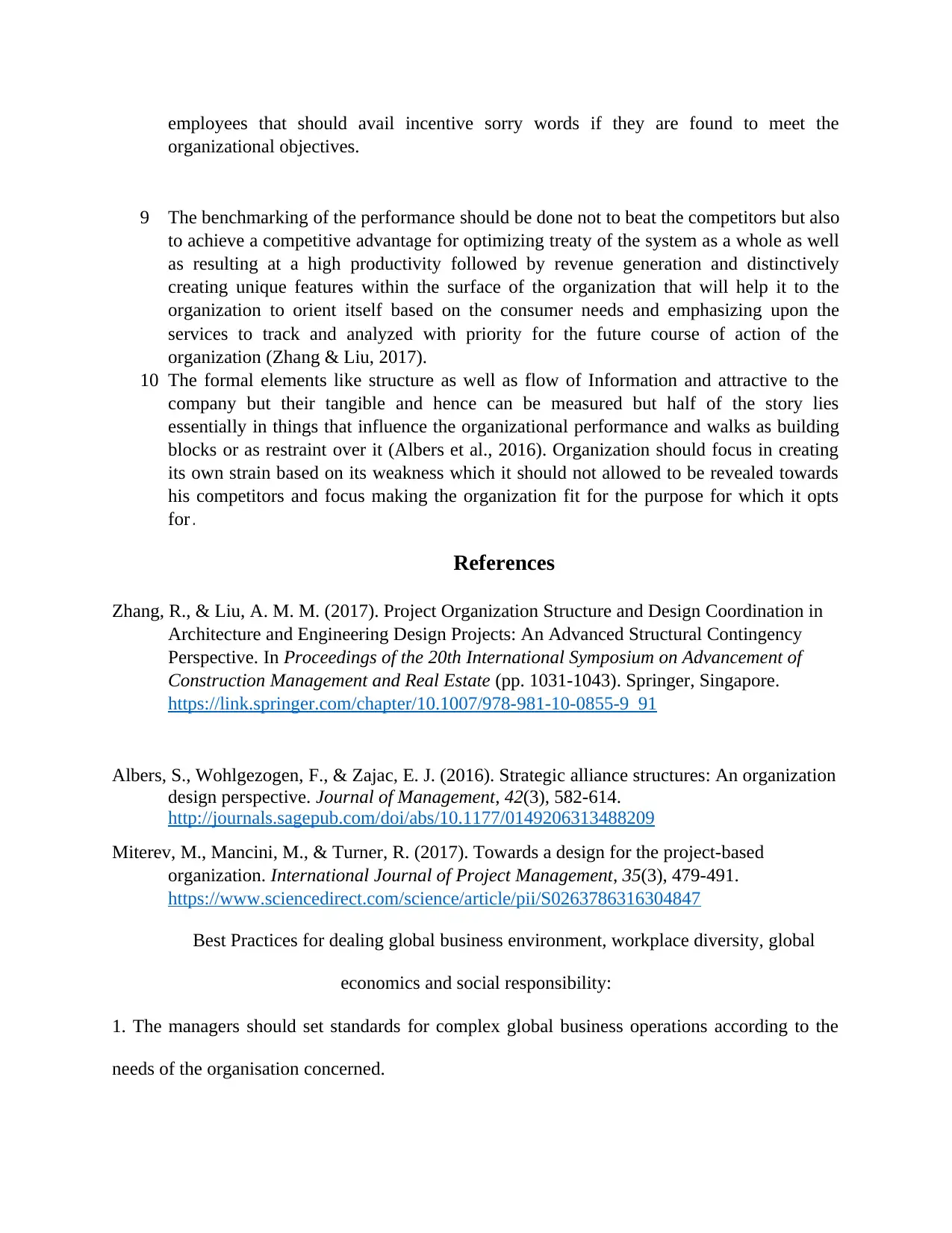
employees that should avail incentive sorry words if they are found to meet the
organizational objectives.
9 The benchmarking of the performance should be done not to beat the competitors but also
to achieve a competitive advantage for optimizing treaty of the system as a whole as well
as resulting at a high productivity followed by revenue generation and distinctively
creating unique features within the surface of the organization that will help it to the
organization to orient itself based on the consumer needs and emphasizing upon the
services to track and analyzed with priority for the future course of action of the
organization (Zhang & Liu, 2017).
10 The formal elements like structure as well as flow of Information and attractive to the
company but their tangible and hence can be measured but half of the story lies
essentially in things that influence the organizational performance and walks as building
blocks or as restraint over it (Albers et al., 2016). Organization should focus in creating
its own strain based on its weakness which it should not allowed to be revealed towards
his competitors and focus making the organization fit for the purpose for which it opts
for.
References
Zhang, R., & Liu, A. M. M. (2017). Project Organization Structure and Design Coordination in
Architecture and Engineering Design Projects: An Advanced Structural Contingency
Perspective. In Proceedings of the 20th International Symposium on Advancement of
Construction Management and Real Estate (pp. 1031-1043). Springer, Singapore.
https://link.springer.com/chapter/10.1007/978-981-10-0855-9_91
Albers, S., Wohlgezogen, F., & Zajac, E. J. (2016). Strategic alliance structures: An organization
design perspective. Journal of Management, 42(3), 582-614.
http://journals.sagepub.com/doi/abs/10.1177/0149206313488209
Miterev, M., Mancini, M., & Turner, R. (2017). Towards a design for the project-based
organization. International Journal of Project Management, 35(3), 479-491.
https://www.sciencedirect.com/science/article/pii/S0263786316304847
Best Practices for dealing global business environment, workplace diversity, global
economics and social responsibility:
1. The managers should set standards for complex global business operations according to the
needs of the organisation concerned.
organizational objectives.
9 The benchmarking of the performance should be done not to beat the competitors but also
to achieve a competitive advantage for optimizing treaty of the system as a whole as well
as resulting at a high productivity followed by revenue generation and distinctively
creating unique features within the surface of the organization that will help it to the
organization to orient itself based on the consumer needs and emphasizing upon the
services to track and analyzed with priority for the future course of action of the
organization (Zhang & Liu, 2017).
10 The formal elements like structure as well as flow of Information and attractive to the
company but their tangible and hence can be measured but half of the story lies
essentially in things that influence the organizational performance and walks as building
blocks or as restraint over it (Albers et al., 2016). Organization should focus in creating
its own strain based on its weakness which it should not allowed to be revealed towards
his competitors and focus making the organization fit for the purpose for which it opts
for.
References
Zhang, R., & Liu, A. M. M. (2017). Project Organization Structure and Design Coordination in
Architecture and Engineering Design Projects: An Advanced Structural Contingency
Perspective. In Proceedings of the 20th International Symposium on Advancement of
Construction Management and Real Estate (pp. 1031-1043). Springer, Singapore.
https://link.springer.com/chapter/10.1007/978-981-10-0855-9_91
Albers, S., Wohlgezogen, F., & Zajac, E. J. (2016). Strategic alliance structures: An organization
design perspective. Journal of Management, 42(3), 582-614.
http://journals.sagepub.com/doi/abs/10.1177/0149206313488209
Miterev, M., Mancini, M., & Turner, R. (2017). Towards a design for the project-based
organization. International Journal of Project Management, 35(3), 479-491.
https://www.sciencedirect.com/science/article/pii/S0263786316304847
Best Practices for dealing global business environment, workplace diversity, global
economics and social responsibility:
1. The managers should set standards for complex global business operations according to the
needs of the organisation concerned.
Paraphrase This Document
Need a fresh take? Get an instant paraphrase of this document with our AI Paraphraser
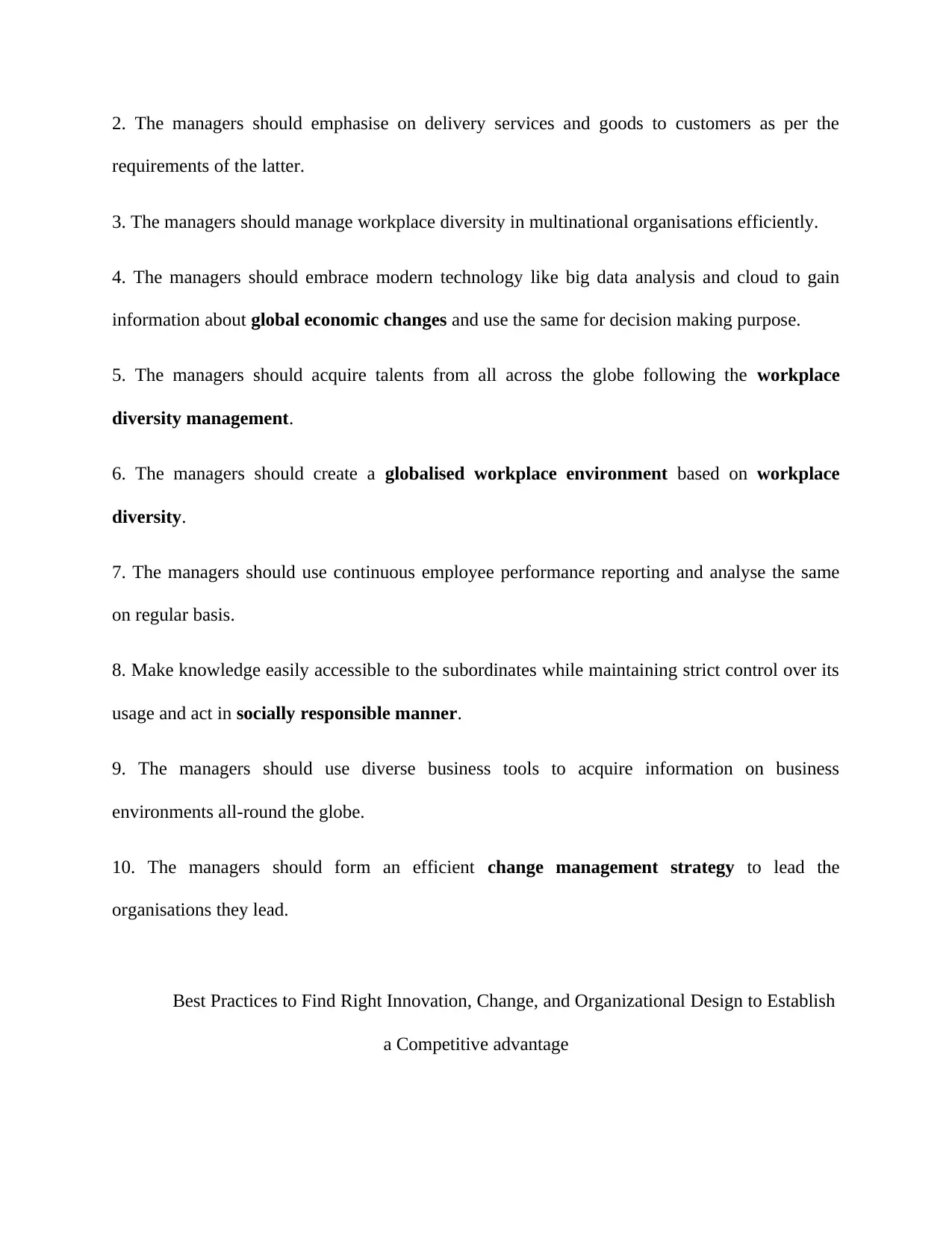
2. The managers should emphasise on delivery services and goods to customers as per the
requirements of the latter.
3. The managers should manage workplace diversity in multinational organisations efficiently.
4. The managers should embrace modern technology like big data analysis and cloud to gain
information about global economic changes and use the same for decision making purpose.
5. The managers should acquire talents from all across the globe following the workplace
diversity management.
6. The managers should create a globalised workplace environment based on workplace
diversity.
7. The managers should use continuous employee performance reporting and analyse the same
on regular basis.
8. Make knowledge easily accessible to the subordinates while maintaining strict control over its
usage and act in socially responsible manner.
9. The managers should use diverse business tools to acquire information on business
environments all-round the globe.
10. The managers should form an efficient change management strategy to lead the
organisations they lead.
Best Practices to Find Right Innovation, Change, and Organizational Design to Establish
a Competitive advantage
requirements of the latter.
3. The managers should manage workplace diversity in multinational organisations efficiently.
4. The managers should embrace modern technology like big data analysis and cloud to gain
information about global economic changes and use the same for decision making purpose.
5. The managers should acquire talents from all across the globe following the workplace
diversity management.
6. The managers should create a globalised workplace environment based on workplace
diversity.
7. The managers should use continuous employee performance reporting and analyse the same
on regular basis.
8. Make knowledge easily accessible to the subordinates while maintaining strict control over its
usage and act in socially responsible manner.
9. The managers should use diverse business tools to acquire information on business
environments all-round the globe.
10. The managers should form an efficient change management strategy to lead the
organisations they lead.
Best Practices to Find Right Innovation, Change, and Organizational Design to Establish
a Competitive advantage
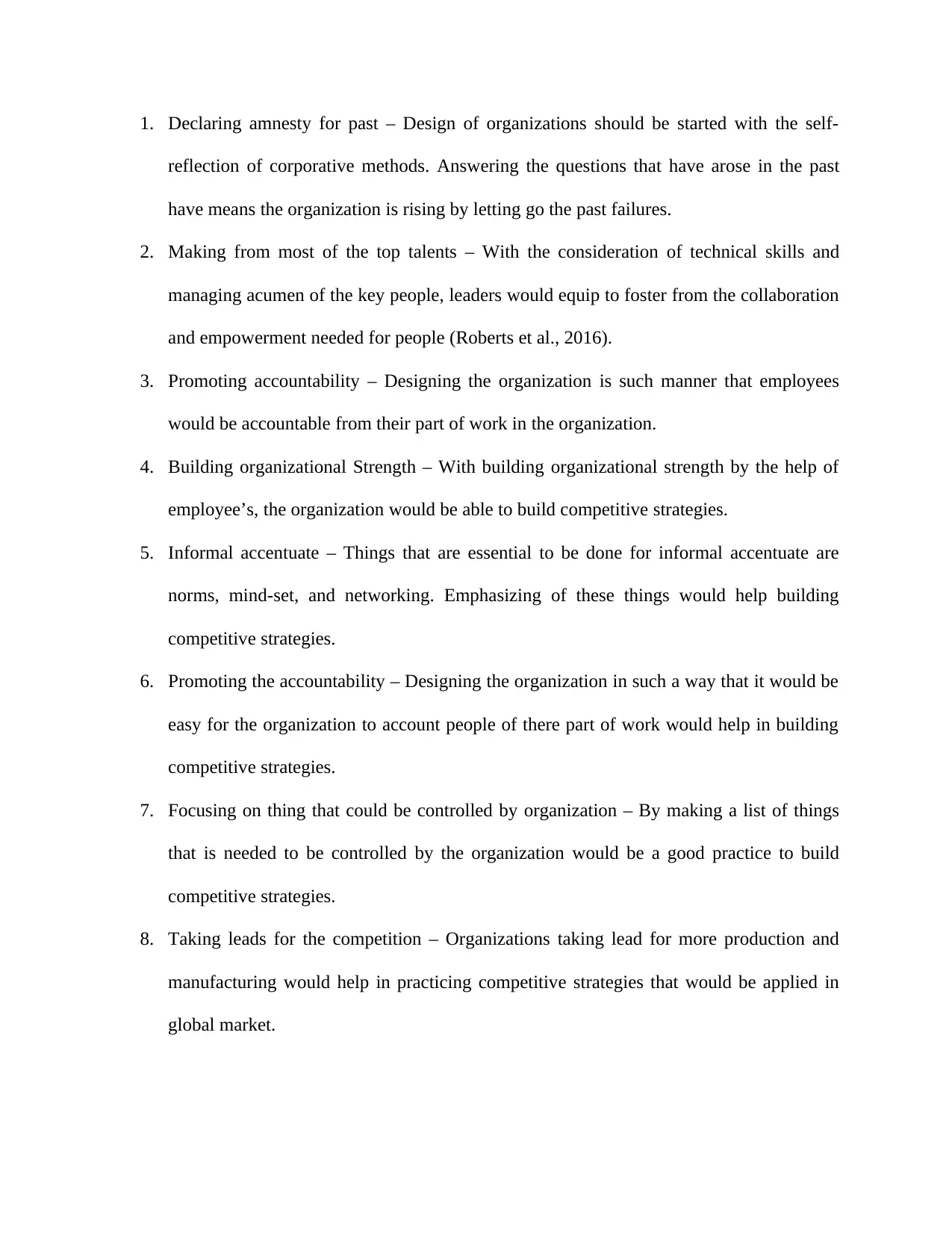
1. Declaring amnesty for past – Design of organizations should be started with the self-
reflection of corporative methods. Answering the questions that have arose in the past
have means the organization is rising by letting go the past failures.
2. Making from most of the top talents – With the consideration of technical skills and
managing acumen of the key people, leaders would equip to foster from the collaboration
and empowerment needed for people (Roberts et al., 2016).
3. Promoting accountability – Designing the organization is such manner that employees
would be accountable from their part of work in the organization.
4. Building organizational Strength – With building organizational strength by the help of
employee’s, the organization would be able to build competitive strategies.
5. Informal accentuate – Things that are essential to be done for informal accentuate are
norms, mind-set, and networking. Emphasizing of these things would help building
competitive strategies.
6. Promoting the accountability – Designing the organization in such a way that it would be
easy for the organization to account people of there part of work would help in building
competitive strategies.
7. Focusing on thing that could be controlled by organization – By making a list of things
that is needed to be controlled by the organization would be a good practice to build
competitive strategies.
8. Taking leads for the competition – Organizations taking lead for more production and
manufacturing would help in practicing competitive strategies that would be applied in
global market.
reflection of corporative methods. Answering the questions that have arose in the past
have means the organization is rising by letting go the past failures.
2. Making from most of the top talents – With the consideration of technical skills and
managing acumen of the key people, leaders would equip to foster from the collaboration
and empowerment needed for people (Roberts et al., 2016).
3. Promoting accountability – Designing the organization is such manner that employees
would be accountable from their part of work in the organization.
4. Building organizational Strength – With building organizational strength by the help of
employee’s, the organization would be able to build competitive strategies.
5. Informal accentuate – Things that are essential to be done for informal accentuate are
norms, mind-set, and networking. Emphasizing of these things would help building
competitive strategies.
6. Promoting the accountability – Designing the organization in such a way that it would be
easy for the organization to account people of there part of work would help in building
competitive strategies.
7. Focusing on thing that could be controlled by organization – By making a list of things
that is needed to be controlled by the organization would be a good practice to build
competitive strategies.
8. Taking leads for the competition – Organizations taking lead for more production and
manufacturing would help in practicing competitive strategies that would be applied in
global market.
⊘ This is a preview!⊘
Do you want full access?
Subscribe today to unlock all pages.

Trusted by 1+ million students worldwide
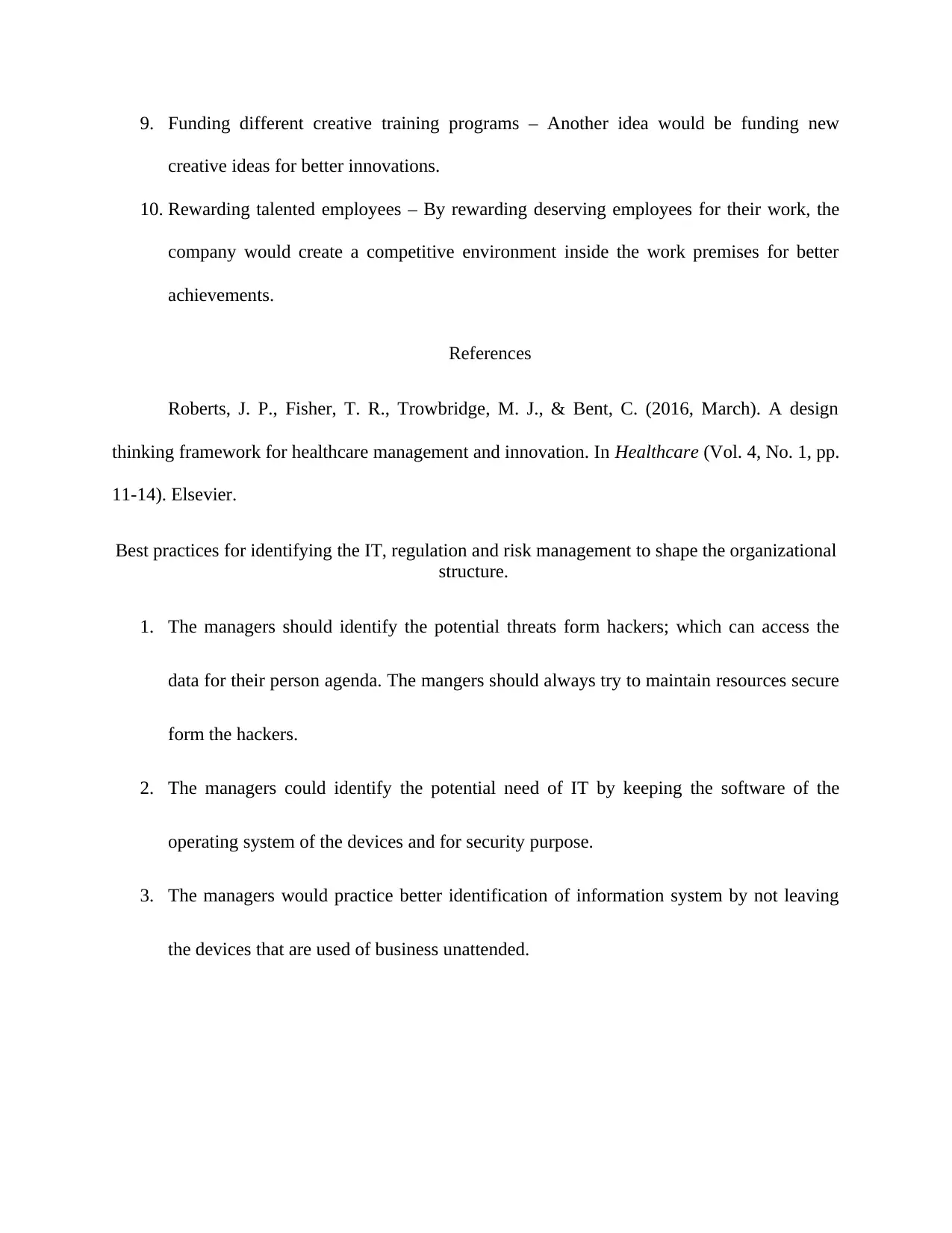
9. Funding different creative training programs – Another idea would be funding new
creative ideas for better innovations.
10. Rewarding talented employees – By rewarding deserving employees for their work, the
company would create a competitive environment inside the work premises for better
achievements.
References
Roberts, J. P., Fisher, T. R., Trowbridge, M. J., & Bent, C. (2016, March). A design
thinking framework for healthcare management and innovation. In Healthcare (Vol. 4, No. 1, pp.
11-14). Elsevier.
Best practices for identifying the IT, regulation and risk management to shape the organizational
structure.
1. The managers should identify the potential threats form hackers; which can access the
data for their person agenda. The mangers should always try to maintain resources secure
form the hackers.
2. The managers could identify the potential need of IT by keeping the software of the
operating system of the devices and for security purpose.
3. The managers would practice better identification of information system by not leaving
the devices that are used of business unattended.
creative ideas for better innovations.
10. Rewarding talented employees – By rewarding deserving employees for their work, the
company would create a competitive environment inside the work premises for better
achievements.
References
Roberts, J. P., Fisher, T. R., Trowbridge, M. J., & Bent, C. (2016, March). A design
thinking framework for healthcare management and innovation. In Healthcare (Vol. 4, No. 1, pp.
11-14). Elsevier.
Best practices for identifying the IT, regulation and risk management to shape the organizational
structure.
1. The managers should identify the potential threats form hackers; which can access the
data for their person agenda. The mangers should always try to maintain resources secure
form the hackers.
2. The managers could identify the potential need of IT by keeping the software of the
operating system of the devices and for security purpose.
3. The managers would practice better identification of information system by not leaving
the devices that are used of business unattended.
Paraphrase This Document
Need a fresh take? Get an instant paraphrase of this document with our AI Paraphraser
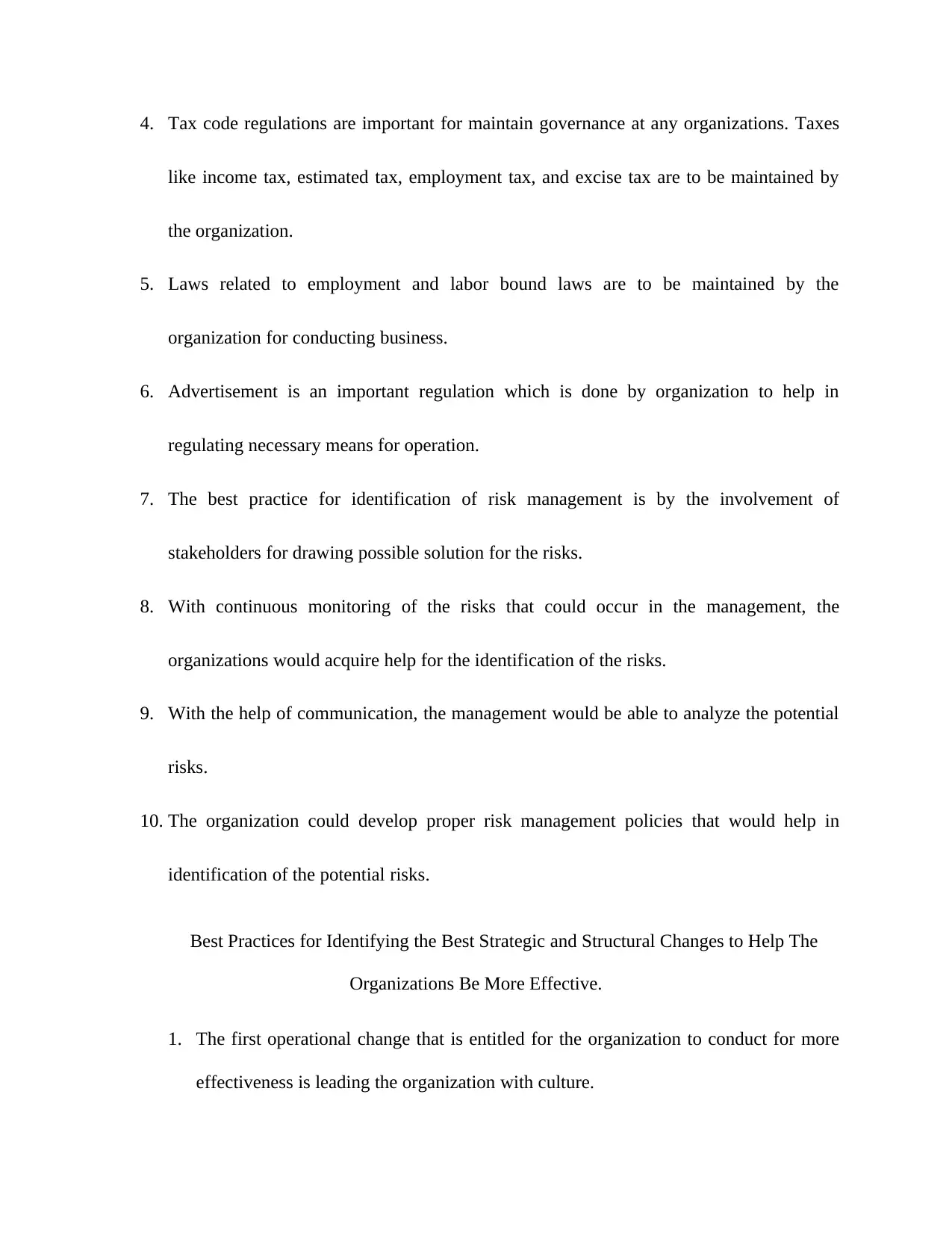
4. Tax code regulations are important for maintain governance at any organizations. Taxes
like income tax, estimated tax, employment tax, and excise tax are to be maintained by
the organization.
5. Laws related to employment and labor bound laws are to be maintained by the
organization for conducting business.
6. Advertisement is an important regulation which is done by organization to help in
regulating necessary means for operation.
7. The best practice for identification of risk management is by the involvement of
stakeholders for drawing possible solution for the risks.
8. With continuous monitoring of the risks that could occur in the management, the
organizations would acquire help for the identification of the risks.
9. With the help of communication, the management would be able to analyze the potential
risks.
10. The organization could develop proper risk management policies that would help in
identification of the potential risks.
Best Practices for Identifying the Best Strategic and Structural Changes to Help The
Organizations Be More Effective.
1. The first operational change that is entitled for the organization to conduct for more
effectiveness is leading the organization with culture.
like income tax, estimated tax, employment tax, and excise tax are to be maintained by
the organization.
5. Laws related to employment and labor bound laws are to be maintained by the
organization for conducting business.
6. Advertisement is an important regulation which is done by organization to help in
regulating necessary means for operation.
7. The best practice for identification of risk management is by the involvement of
stakeholders for drawing possible solution for the risks.
8. With continuous monitoring of the risks that could occur in the management, the
organizations would acquire help for the identification of the risks.
9. With the help of communication, the management would be able to analyze the potential
risks.
10. The organization could develop proper risk management policies that would help in
identification of the potential risks.
Best Practices for Identifying the Best Strategic and Structural Changes to Help The
Organizations Be More Effective.
1. The first operational change that is entitled for the organization to conduct for more
effectiveness is leading the organization with culture.
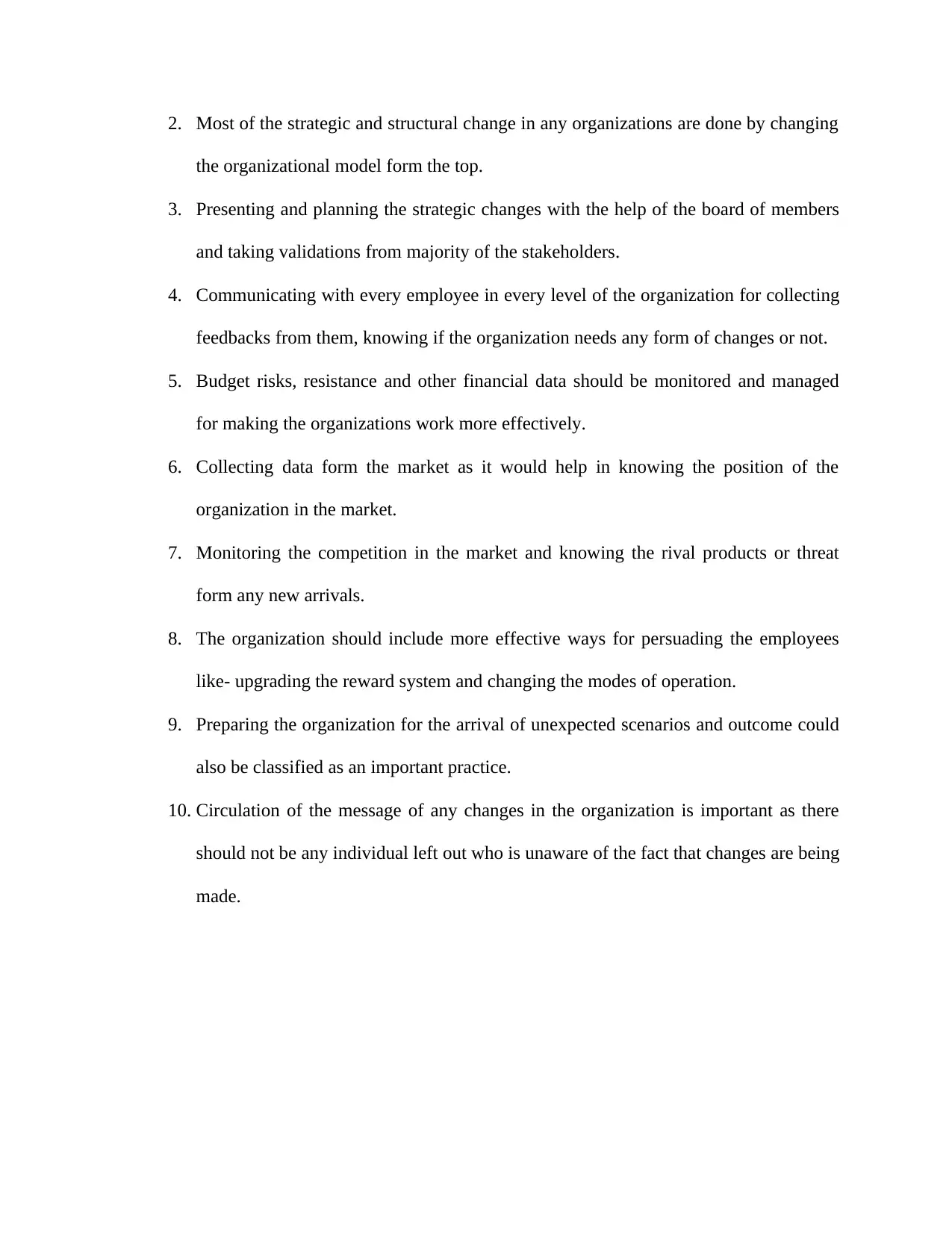
2. Most of the strategic and structural change in any organizations are done by changing
the organizational model form the top.
3. Presenting and planning the strategic changes with the help of the board of members
and taking validations from majority of the stakeholders.
4. Communicating with every employee in every level of the organization for collecting
feedbacks from them, knowing if the organization needs any form of changes or not.
5. Budget risks, resistance and other financial data should be monitored and managed
for making the organizations work more effectively.
6. Collecting data form the market as it would help in knowing the position of the
organization in the market.
7. Monitoring the competition in the market and knowing the rival products or threat
form any new arrivals.
8. The organization should include more effective ways for persuading the employees
like- upgrading the reward system and changing the modes of operation.
9. Preparing the organization for the arrival of unexpected scenarios and outcome could
also be classified as an important practice.
10. Circulation of the message of any changes in the organization is important as there
should not be any individual left out who is unaware of the fact that changes are being
made.
the organizational model form the top.
3. Presenting and planning the strategic changes with the help of the board of members
and taking validations from majority of the stakeholders.
4. Communicating with every employee in every level of the organization for collecting
feedbacks from them, knowing if the organization needs any form of changes or not.
5. Budget risks, resistance and other financial data should be monitored and managed
for making the organizations work more effectively.
6. Collecting data form the market as it would help in knowing the position of the
organization in the market.
7. Monitoring the competition in the market and knowing the rival products or threat
form any new arrivals.
8. The organization should include more effective ways for persuading the employees
like- upgrading the reward system and changing the modes of operation.
9. Preparing the organization for the arrival of unexpected scenarios and outcome could
also be classified as an important practice.
10. Circulation of the message of any changes in the organization is important as there
should not be any individual left out who is unaware of the fact that changes are being
made.
⊘ This is a preview!⊘
Do you want full access?
Subscribe today to unlock all pages.

Trusted by 1+ million students worldwide
1 out of 12
Related Documents
Your All-in-One AI-Powered Toolkit for Academic Success.
+13062052269
info@desklib.com
Available 24*7 on WhatsApp / Email
![[object Object]](/_next/static/media/star-bottom.7253800d.svg)
Unlock your academic potential
Copyright © 2020–2025 A2Z Services. All Rights Reserved. Developed and managed by ZUCOL.





